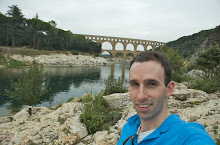It's now my fourth and final day in Italy's capital, and Rome has grown on me. I still think it's a harder city to warm to than Venice or Florence, but if you find the right places it certainly has an appeal. Obviously it's bigger and busier than other Italian cities, and also has more beggars and a daunting number of tourists. It can be disenchanting when you walk miles only to hear English, see others carrying guidebooks and find more restaurants with menus in multiple languages. Where do the locals live? I think you have to go some way outside the city centre, although today I did manage to find two welcome escapes. The first was the
Borghese Gardens in the city's north, a large public park with plenty of space, trees and water fountains to get away from the crowds and relax.
While strolling back to my hotel around lunch time, I came across an area with lots of little cafes popular with Italians. I think it was a business type area, and much more pleasant/upmarket than the area I'm staying in (which is filled with lots of cheap hotels). The food (quiche with vegetables) way yummy and much cheaper than other places I've been. It was the first place I've found in Rome that did not cater to tourists.
Gratefully, I was forced to relax today. I say forced because almost all the museums in Rome are closed on Mondays. I still squeezed in quite a few sights this morning, including The Pantheon, Spanish Steps, Piazza Navone (a large square featuring a famous water fountain by Bernini the Fountain of the Four Rivers), and one of the city's only Gothic churches (most are Baroque), Santa Maria sopra Minerva.
The previous two days have been jam-packed and worn me out. Saturday I went on a five-hour guided tour of the Vatican Museums and St Peter's Basilica. It might sound like a long tour, but such is the size of the museums, that you really only scratch the surface. Nonetheless, they are very impressive and, once more, taking a guided tour was worthwhile as the guide gives a lot of the context and background that gives meaning to the paintings, frescoes, tapestries, mosaics, sculptures and buildings. It also worked well having been on the Uffizi tour, as the Vatican tour built on my understanding of the various art periods, particularly the Renaissance. The guide provided a lot of intriguing details on artistic techniques, such as how frescoes are created, which gave me a new found appreciation for them. This all led up to the Sistine Chapel with Michelangelo's frescoed ceiling and his Last Judgement.
St Peter's Basilica is very impressive, with the largest interior of any Christian chruch in the world.
Michelangelo's pieta is quite breathtaking, and I was glad to see this not long after appreciating Il David in Florence. However, I did find
Bernini's bronze furnishings a bit much. I would go so far as to call them gaudy. Hope that's not sacriligeous! I can now say I definitely prefer Renaissance art and architecture over Baroque.
Yesterday (Sunday) I took guided tours to the Colosseum, Roman Forum and Palatine Hill. The Colosseum is such an Italian icon and on a huge scale. What an engineering feat! Our tour guide Ian, an archeologist from Liverpool, brought the venue to life with gladiatorial stories and a captivating philosophy on the human fascination with death, suggesting that we have not changed as much as we might think since the time of the Romans.
Next was a visit to the nearby
Roman Forum, the central area around which the
ancient Roman civilization developed. It's hard to comprehend how old this place is, with structures here in the 7th Century BC. Ian also did a wonderful (scouser!) rendition of Shakespeare's
Julius Caeser, when Brutus and Antony were addressing the crowds in the very Forum where we stood. There can be few better ways to appreciate the story!
After lunch was the final part of the tour,
Palatine Hill, sited above the Forum. I think this was the highlight of the day, and probably of my visit to Rome. This is where the original Romans lived, and you can walk through the remains of dozens of buildings. I think this is where Ian's training as an archeologist came to the fore, as he explained many of the innovative Roman building techniques and revealed how advanced their technology was. This included earthquak resistant building foundations and flushing toilets! He also helped you imagine how impressive many of the structures once were and with a splash of water revealed how a seemingly dull tile was extraordinarily beautiful beneath the dust.
I finished the day with a trip to Trastevere (translates as across the Tiber), a working-class district full of cafes, bars and restaurants. Unfortunately it has become very popular, and so was near impossible to find a "non touristic" restaurant. I had some hand-made spinach and ricotta ravioli and braved it by trying Trippa alla Romana (tripe, Rome style). I can't say I was a fan. I ate about half of it, and the sauce was nice, but the texture of the tripe was a bit off-putting. I also visited a beautiful church, Santa Maria in Trastevere, where I caught the end of a service. Although I am not religious, the atmosphere created by the choir was wonderful.
One of my favourite things about Rome is coming across ancient structures. You're walking up a non-descript street and suddenly there's the remnants of some ancient Roman building in front of you, with no plaque or explanation, because there are so many of them!









































